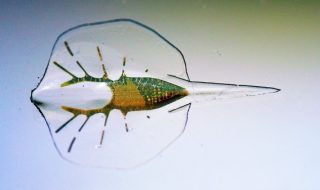A stingray created from living rat cells blurs the line between technology and nature.

Image credits Karaghen Hudson and Michael Rosnach
Creating machines from living cells not only takes us closer to the creation of entire organs, it also highlights the possibility of integrating cells and electronics into robots in order to allow for internal intelligence. Using living rat cells, a team of researchers has created a stingray robot that can be controlled using its light-responsive cells and marks a step forward in the field.
“We built a stingray that doesn’t have its own brain and is controlled by light signals from outside,” said Kevin Kit Parker of Harvard University and senior author of the study. “It’s alive, but it’s not an organism – it can’t replicate, it can’t reproduce. We make them in batches of five or six, and they live about a week, maybe less.”
The team begins by creating a gold skeleton in the shape of a stingray and covering it with a layer of flexible plastic and a thicker layer of silicone rubber; gold was chosen specifically for its chemically inert nature. With the foundation in place, the scientists then top it off with muscle cells from rat hearts.
Upon stimulation, the living rat cells contract and pull the robot’s fins downward. In order to keep the robot light, the team designed it so that some of the energy used during this contraction process is stored and used to help the fins rise.
The team genetically engineering the stingray robot’s cells to respond to light, allowing them to steer it left or right using asymmetric pulses of light. With a speed of around 0.06 inches per second, the scientists guided the robot through an obstacle course that covered a distance of nearly 10 inches.
Ultimately, Parker and his team plan to use their research to create replacement organs – including hearts – for sick children.
“We’re already looking at building a robot based off another marine life-form to test our skill set a bit more,” he said.
Journal Reference: Phototactic guidance of a tissue-engineered soft-robotic ray. Published 8 July 2016. 10.1126/science.aaf4292









